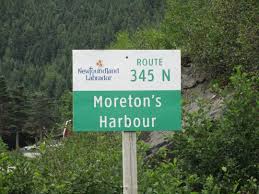“Did you hear the news?”
“What news?”
“The Captain’s wife had her baby!”
“Wonderful! Boy or girl?”
“It’s a boy!”
“Does he have a name yet?”
“They’re naming him CLARENCE.”
The above dialogue may well have taken place in a small fishing village in Newfoundland back in 1907. That’s when and where this story has its beginning. The Salvation Army officers in charge of the corps in Moreton’s Harbour were blessed with a newborn. While still an infant, young Clarence would move to Canada - his parents having been transferred up-a-long. There he would grow up and one day follow in his parents footsteps, becoming a Salvation Army officer.
Newfoundland, however, was not finished with young Clarence for at the ripe old age of thirty-eight he moved back to the rock as the newly appointed Provincial Commander, in charge of the Salvation Army’s work in what soon would become Canada’s tenth province! The following is a thumb-nail sketch of his life as taken from the dust cover of A BURNING IN MY BONES (An Anecdotal Autobiography) by Clarence D. Wiseman, McGraw-Hill Ryerson Limited, Toronto 1979
[[-Clarence D. Wiseman was born in 1907 at Moreton’s Harbour, Newfoundland, of parents who were active Salvation Army officers. He was commissioned as a Salvation Army officer in 1927 and until 1940 commanded a number of corps in Ontario and Quebec. During World War II he was first a chaplain and then the Senior Salvation Army Representative with the Canadian Forces. From 1945 to 1954 he was in charge of Salvation Army work in Newfoundland, and from 1957 to 1960 he was Chief Secretary for Canada and Bermuda. In 1960 he went to East Africa and in 1962 he became Principal of the International Training College in London. He returned to Toronto as Territorial Commander for all of Canada and Bermuda in 1967. In 1974 he was elected General of the International Salvation Army, and he retired, from this position in 1977.-]]
Of particular interest for us today is the sentence which reads: “During World War II he was first a chaplain and then the Senior Salvation Army Representative with the Canadian Forces.”
The following information comes from government/public online-web-sights and again gives a brief sketch – this time of the history of The Salvation Army Red Shield Services during WWII:
[[- The onset of World War II found the Army accompanying Canada’s armed forces overseas not only as chaplains but as the operators of Maple Leaf Clubs, providing rest and relaxation for the troops.
By the end of the war there were clubs in Britain, France, Germany, Belgium, Holland, and India. They were mostly staffed by Salvation Army Auxiliaries, some of them as young as twenty years old. They provided a taste of home, with Canadian cooking, mail forwarding, and social activities, including dances and short-term accommodation. On the home front at the end of the war, Salvationists at Canadian ports welcomed the ‘war brides’ of Canadian servicemen. - ]]
[[ - In November 1939, Ottawa accorded the Salvation Army official status as a Canadian War Auxiliary Service, a distinction also awarded the Canadian Legion, the Young Men’s Christian Association, and the Knights of Columbus.
The SA understood that Ottawa’s co-ordination of all Auxiliary War Services would eliminate duplication of effort in matters affecting military welfare. In 1942, each group agreed to specialize in certain fields, with the SA assuming responsibility for canteens and the showing of films.
Other responsibilities included organizing recreational activities such as concerts or sporting events, providing reading material and stationery, comforting the wounded, or even helping bury the dead. In short, they did whatever was necessary to help morale. The SA instructed its supervisors to "care for the body, mind, and soul of every [service person] irrespective of...creed or personality."
Red Shield supervisors retained their status as civilians but held military rank equivalent to an army captain. In 1940, Ottawa issued each the uniform (minus rank insignia) of their respective service and units with the addition of Red Shield and Auxiliary War Services badges.
During Canadian training exercises in Britain, the SA’s mobile canteens supplied tired men with coffee, donuts, chocolates, and cigarettes. By early 1944, 70 Red Shield supervisors operated 30 centres and 55 mobile canteens in support of Canadian army and air force units. Moreover, the SA film service’s 375 projectors in Britain showed two complete programs weekly.
The SA rest camp for the Royal Canadian Navy in Northern Ireland had one unforeseen but welcome consequence: a local magistrate noted that following the establishment of the facility, the number of Canadian sailors appearing before Londonderry courts dropped 50 per cent!
In July 1943, Canadian troops participated in the Allied invasion of Sicily. SA supervisors accompanied them. Fifteen were assigned to help alleviate the Canadians’ stressful experience of sustained combat, including three who landed almost immediately after the initial assault. In June 1944, the Allies began the liberation of Northwest Europe by invading Normandy, France.
Within days of the initial assault, the first of 40 Red Shield supervisors to serve in Northwest Europe were ashore; they showed their first film to the exhausted men just five days after the invasion.
The Red Shield men followed the unit (normally battalion-sized) to which they were attached, identifying with it and getting to know the men. By this stage of the war, each supervisor was equipped with a large truck carrying a portable generator, movie projector, turntable, radio, sports equipment, games, and canteen supplies. Two military personnel were assigned to each supervisor as assistants. - ]]
There were a number of Canadian Salvationists who were very active in the above ministry helping to initiate, develop, and expand this whole program – both lay people and officers. Perhaps the one known best would be none other than the late General Clarence D. Wiseman. The following paragraphs are taken again from: A BURNING IN MY BONES An Anecdotal Autobiography by Clarence D. Wiseman, McGraw-Hill Ryerson Limited, Toronto 1979, pp. 73-74
[[- Not long after my appointment to War Services we erected the Red Shield over another unique center, this time a leave hotel for officers of the R.C.A.F. It was the London home of the Woolworth heiress, Barbara Hutton, situated in Regent Park. My preliminary survey of the mansion revealed some areas so lavishly decorated that we felt obliged to close them off to common use. Supervisors with the air force were very proud of this center as well as the others we had established for airmen in Lincoln, Stratford-on-Avon, and Leamington. Nearly all our clubs throughout Britain were magnificently managed by Salvationist women from Canada, many of them the wives of supervisors.
Not for a moment did Red Shield supervisors lose sight of their spiritual mission. As one officer of high rank told a Red Shield man, “You fellows seem to have the knack of religion.” The knack of religion! Well, they showed in their sing-songs and religious services. Sometimes, too, there was indirect witness, like the picture of Jesus above the main fireplace in the Westminster Central Hotel, which often became a conversation piece. Probably most effective were the quiet personal words with soldier, airman, or sailor at a moment of deep need. The spiritual impact of the Red Shield was beyond computation. -]]
Amen!
“You fellows seem to have the knack of religion.”
Lest we forget.







Leave a Comment